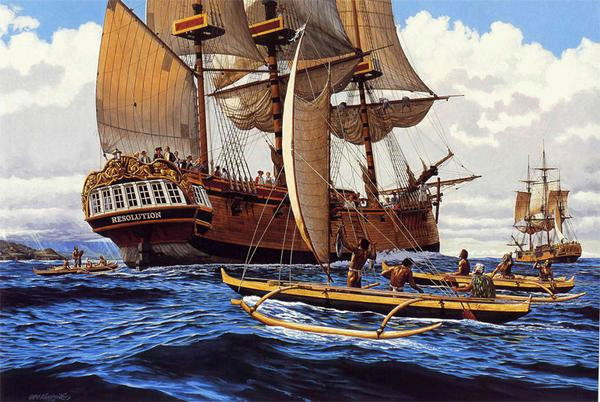
Captain Cook's arrival in Waimea, Kauai.
We always recall that Captain James Cook died at Kealakekua Bay on the Big Island, but often overlook that the first reported contact by the white man in the islands occurred in Waimea, Kauai. Hawaiian lives changed with sudden and lasting impact when in1778, Cook and his crew arrived. Western contact changed the course of history for Hawai‘i.
Cook named the archipelago the Sandwich Islands in honor of his patron, the First Lord of the Admiralty, the Earl of Sandwich.
At the time of Cook’s arrival (1778-1779), the Hawaiian Islands were divided into four kingdoms: (1) the island of Hawaiʻi under the rule of Kalaniʻōpuʻu, who also had possession of the Hāna district of east Maui; (2) Maui (except the Hāna district,) Molokai, Lānai and Kahoʻolawe, ruled by Kahekili; (3) Oʻahu, under the rule of Kahahana; and at (4) Kauai and Niʻihau, Kamakahelei was ruler.
Cook's crew first sighted the Hawaiian Islands in the dawn hours of January 18, 1778. His two ships, the HMS Resolution and the HMSDiscovery, were kept at bay by the weather until the next day when they approached Kauai’s southeast coast.
On the afternoon of January 19, native Hawaiians in canoes paddled out to meet Cook’s ships, and so began Hawai‘i’s contact with Westerners. The first Hawaiians to greet Cook were from the Kōloa south shore. The Hawaiians traded fish and sweet potatoes forpieces of iron and brass that were lowered down from Cook’s ships to the Hawaiians’ canoes.
Cook continued to sail along the coast searching for a suitable anchorage. His two ships remained offshore, but a few Hawaiians were allowed to come on board on the morning of January 20, before Cook continued on in search of a safe harbor.On the afternoon of January 20, 1778, Cook anchored his ships near the mouth of the Waimea River on Kauai’s southwestern shore.
As they stepped ashore for the first time, Cook and his men were greeted by hundreds of Hawaiians who offered gifts of pua‘a (pigs), and mai‘a (bananas) and kapa (tapa) barkcloth. Cook went ashore at Waimea three times the next day, walking inland to where he saw Hawaiianhale (houses), heiau (places of worship) and agricultural sites. At the time, the region was thriving with many thatched homes as well as lo‘i kalo (taro patches) and various other food crops such as niu (coconuts) and ‘ulu (breadfruit).
After trading for provisions, gathering water and readying for sail, Cook left the island and continued his search of the “Northwest Passage,” an elusive (because it was non-existent) route from the Pacific Ocean to the Atlantic Ocean.
After the West Coast, Alaska and Bering Strait exploration, on October 24, 1778 the two ships headed back to the islands; they sighted Maui on November 26 and circled the Island of Hawaiʻi.
On January 17, 1779, Cook sailed into Kealakekua Bay on the island of Hawai‘i. After a month's stay, Cook got under sail again to resume his exploration of the Northern Pacific. Shortly after leaving Hawaiʻi Island, the foremast of the Resolution broke and the ships returned to Kealakekua Bay for repairs.
On February 14, 1779, at Kealakekua Bay, some Hawaiians took one of Cook's small boats. He attempted to take hostage the King of Hawaiʻi, Kalaniʻōpuʻu. The Hawaiians prevented this and Cook and some of his men were killed. Clerke took over the expedition and they left.
--© 2023 Ho‘okuleana LLC.

 Richard dot J dot Wagner at gmail dot com
Richard dot J dot Wagner at gmail dot com
index.html, this hand crafted, human readable HTML file was created January 19, 2023.
Last updated January 19, 2023, by Dr. Richard J. Wagner.
Copyright © 2023 by Richared J. Wagner, all rights reserved.